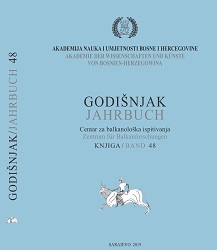“Macedonian Amphoras” at Kale, Krševica Site – Another Evidence about Chronology of the Iron Age Settlement and Connections with the Hellenistic World
“Macedonian Amphoras” at Kale, Krševica Site – Another Evidence about Chronology of the Iron Age Settlement and Connections with the Hellenistic World
Author(s): Petar Popović, Aca ĐorđevićSubject(s): Archaeology, Cultural history, Local History / Microhistory, Ancient World
Published by: Akademija Nauka i Umjetnosti Bosne i Hercegovine
Keywords: Kale-Krševica; Hellenistic period; Celts; Macedonian amphora;
Summary/Abstract: Archaeological finds discovered in the course of the investigations at the site Kale near Krševica village confirmed the exceptional importance of that site. Large scale excavations conducted at the site from 2001 to 2018 revealed the remains of the settlement dating from the 4th – 3rd centuries BC. Settlement with the acropolis was at the dominant position in the vicinity of Južna Morava. From there it was easy to reach Macedonia and the Aegean via the passages along the Vardar river valley. Many discovered artifacts including metal objects, fragments of Greek painted pottery, large quantity of amphoras, which mainly originate from the vineyard regions around the towns of Thasos and Mende confirm the intensive relations between Krševica and the southeast Europe. For this occasion we selected from the various amphora types only few specimens, which differ from the older ones and are characterized by disk foot, ovoid or baggy body with rounded or angular shoulder, long, thin neck, flaring or projecting rim with sharp ridge well below, strap handles from shoulder to ridge. They are also known as “Macedonian amphora” type and they are related to the Hellenistic period. From the same period dates the remains of the large vaulted structure below the acropolis. Settlement at Krševica had been also known to the Celts. Many pits with large quantity of the Celtic finds were found at the acropolis. The material dates from the 2nd–1st centuries BC, from the time of clashes between the Celts and the Romans after the fall of Macedonia.
Journal: Godišnjak Centra za balkanološka ispitivanja
- Issue Year: 2019
- Issue No: 48
- Page Range: 231-235
- Page Count: 5
- Language: English

